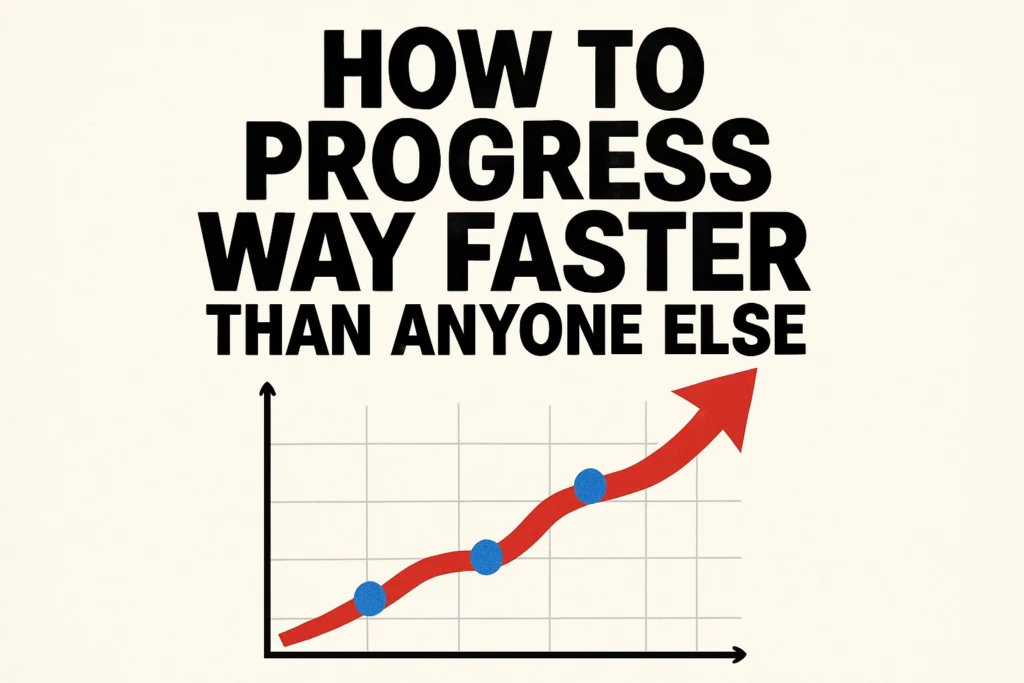Table of Contents
ToggleHow To Progress Way Faster Than Anyone Else

Accelerated Progress: Conviction, Persistence, and Execution
The Path to Accelerated Progress
This document summarizes key points and actionable insights, "How To Progress Way Faster Than Anyone Else," focusing on strategies for achieving significant progress in business and personal endeavors.
I. The Fallacy of the Perfect Plan: Conviction Over Perfection
A central theme is the idea that
"most of the time we need perfect conviction about our plan more than we need a perfect plan."
The author likens progress to climbing a mountain, emphasizing that while multiple paths exist, the critical factor is sticking to a chosen path rather than constantly switching.- Jumping Paths is Detrimental: The source highlights that
"none of the paths will work if you're constantly trying to jump from path to path."
This frequent switching, driven by the search for an ideal, less steep, or seemingly easier route, ultimately leads to slower progress. - Wasted Effort in Switching:
"It's actually a lot longer to keep switching paths."
Each switch often requires"going back down and then you got to go over and you got to go up again,"
wasting valuable effort and time. - Focus on Execution: The ability to
"execute on the path, walk the path, stick to the path is ultimately the thing that's going to predicate your success far more than the path itself provided it's sensible."
The author admits to personally experiencing this"fallacy of the perfect pick,"
where overanalysis of the "perfect plan" hindered actual progress, as evidenced by managing nine businesses without profitability due to being"so spread thin."
- Simple Actions, Consistent Application: Even basic knowledge, like
"stop eating crap and you should start moving more"
for fitness, if consistently applied for three years, would yield significant results. The problem isn't usually a lack of knowing what to do, but a lack of doing it.
II. The Power of Persistence and Enduring Uncertainty
The document strongly advocates for persistence and the willingness to navigate periods of "not knowing."
- Beating the Competition Through Endurance:
"You can beat most people at anything if you just stick with it for a year."
The"bar for excellence has never been so low,"
as"most of your competition quits after the first sign of difficulty."
- Embracing the Unknown: The truly challenging part of progress is
"having to figure something out,"
or"the unknown."
Many individuals give up during this period of uncertainty, falsely believing they need a new strategy when they simply need to"grit through that period where you don't know what you're doing."
- Success Through Mistakes:
"A lot of success comes to sticking with something long enough to make the number of mistakes required to actually figure it out."
Constant restarts equate to"starting from zero every single month."
- Pain and Uncertainty as Catalysts: Ultimately,
"you can beat 99% of people without being smarter or luckier but by being willing to endure pain and uncertainty for longer."
III. Execution as the Core Problem: Culture, Talent, and Training
The source identifies execution as the fundamental issue preventing progress and breaks it down into three critical components: culture, talent, and training. The author dismisses the notion of a single "secret thing" in business, stating
"there's usually lots of ways to win."
The"sharpness of your knife is your ability to execute."
A. Culture: The Rules of Reinforcement
Culture is defined as
"the rules of reinforcement in a business,"
governing"what gets rewarded and what gets punished."
- Defining Acceptable Behavior:
"Who you hire and who you fire tells more to your team about what you think is acceptable."
Similarly,"the behavior that you do not allow to change"
sets cultural norms. For example, if someone is late and no one addresses it,"you teach everyone it's okay to be late."
- Specificity in Feedback: To address non-performance, it's crucial to be
"very specific with what makes somebody not perform."
The author recommends the "start, stop, keep" framework for giving actionable feedback:- Start: What do you want them to begin doing?
- Stop: What do you want them to cease doing?
- Keep: What existing behaviors should be reinforced?
B. Talent: The Quality of People
Talent refers to
"the people who are actually doing the behaviors doing the stuff."
The author stresses that many businesses are hindered by their inability to execute due to"the quality of the people."
- Raising the Bar for Hiring:
"You probably don't have high enough bar for who should be working for you."
Investing in higher-quality talent, even if it costs more, is an"arbitrage opportunity."
A 90th percentile performer costing 30% more might be"five times more effective,"
representing a"great deal."
- Hiring for Obsession: The key is to find
"rain makers,"
people who are"exceptional who are obsessed with this task."
During interviews, inquire about candidates'"off time"
activities. If"what they do in their off time is not what I want them to do in their full-time,"
they are unlikely to be fully engaged in the role. Look for individuals whose"discretionary effort and time"
are spent on developing the skills critical to the role. - Intelligence and Work Ethic Over Experience (for certain roles): For lower-level positions, the author prioritizes
"general intelligence and has work ethic over somebody who might be more experienced... because I think the smart person will be able to catch up to that dumber person really quickly and then pass them."
C. Training: Translating Concepts into Action
Training bridges the gap between potential and actual performance, ensuring that people understand and can execute the plan.
- Bridging the "Why Aren't They Doing the Plan?": The reason a plan isn't working is often that
"no one's doing the plan."
- Translating Big Words into Small Actions: The critical mistake in training is using vague concepts (e.g., "accountability") without defining concrete behaviors.
"No one knows what it means."
Instead,"we have to translate these big words into smaller actions that we want someone to make."
- Example: Instead of "hold someone accountable," specify:
"You need to text your team every morning," "do end of week reports," "give kudos to people who did well," and "ask people who didn't do well what they were struggling with and then drill them on how to improve that skill."
- Specificity Enables Feedback: When behaviors are clearly defined, it becomes
"very easy to say 'Hey, you didn't do these four things,' rather than 'you didn't hold someone accountable.'"
This resolves differing definitions and allows for targeted improvement.
IV. Conclusion: Unlocking Progress Through Focused Effort
The document concludes by reiterating that changing strategies endlessly will not lead to success. Instead, the path up the mountain is unlocked by addressing the underlying issues of execution:
- Talent Issue: Recruit better.
- Culture Issue: Show leaders how to punish and reward behavior.
- Productivity Issue (Training): Improve training by defining concrete actions.
The ultimate takeaway is that
"most time we just need to do what we're doing a little better, a little different,"
which"unlocks the path of the mountain so you can see it."
This approach reduces uncertainty and provides specific "drill bits" to overcome obstacles on the chosen path, rather than resorting to constant reinvention.Accelerated Progress: FAQ
1. Why do so many people struggle to make progress despite having good intentions or even knowledge of what to do?
Many people struggle because they fall prey to the "fallacy of the perfect pick" – the belief that they need to find the absolute best or "perfect" strategy before taking action. Instead of committing to a sensible path and executing it, they constantly switch strategies, believing a different approach will be easier or more effective. This leads to a cycle of starting over and never gaining momentum or learning from the difficulties inherent in any path. The core issue isn't a lack of knowledge about what to do (e.g., to get in shape, stop eating crap and move more), but rather a failure to consistently act on that knowledge.
2. What is the "mountain analogy" and what does it teach about achieving goals?
The "mountain analogy" describes achieving a goal as climbing a mountain. There are often multiple paths to the summit, none of which are perfect. The crucial insight is that success comes from having "perfect conviction about our plan more than we need a perfect plan." Constantly jumping from one path to another (i.e., switching strategies) is detrimental because each switch often means going back down and then up a new incline, making the overall journey much longer. The analogy emphasizes that sticking with a chosen path, even when it becomes difficult or uncertain, is far more important than the initial choice of the path itself, provided it's a sensible one.
3. Why is "sticking with the plan" more important than "coming up with the perfect plan"?
Sticking with the plan is paramount because most sensible strategies will yield results if consistently executed. The video highlights that "you can beat most people at anything if you just stick with it for a year." The primary challenge isn't the flaw in the plan, but the lack of execution and perseverance. Many people quit at the first sign of difficulty or uncertainty, assuming the path is wrong rather than understanding that enduring discomfort is a necessary part of progress. True breakthroughs come from pushing through the "not knowing" or the "figuring it out" phase, which is where most give up.
4. What are the two main underlying issues that prevent effective execution, and how do they manifest?
The two main underlying issues preventing effective execution are culture and talent. Culture refers to the unwritten rules of reinforcement within an environment, defining what behaviors are rewarded and punished. If the desired behaviors (e.g., performance, punctuality) are not consistently rewarded, or undesired behaviors (e.g., lateness, non-performance) are not punished, a "culture of non-performance" can develop. Talent refers to the quality of the people executing the plan. Many businesses struggle because they don't have a high enough bar for who they hire, leading to a workforce that lacks the necessary dedication, skill, or obsession for their roles.
5. How can an organization improve its "culture" to foster better execution?
To improve culture, an organization must clearly define and consistently enforce the "rules of reinforcement." This involves:
- Who you hire and fire: The people allowed to remain in the business send a powerful message about what is acceptable.
- Rewarding good behavior: Consistently acknowledging and rewarding positive actions reinforces them.
- Addressing undesired behavior: Promptly addressing and correcting negative behaviors teaches that they are not acceptable. The speaker suggests using a "start, stop, keep" framework for feedback: "What do you want them to start doing, stop doing, and keep doing?" This provides clear, actionable guidance.
6. How can an organization improve its "talent" to enhance execution, and what is the "arbitrage opportunity" mentioned?
Improving talent involves setting a higher bar for hiring and seeking out "rainmakers" – individuals who are exceptional and obsessed with their work. The "arbitrage opportunity" refers to the idea that paying a higher salary (e.g., 90th percentile) for a top performer, who might only cost 30% more, can result in someone who is "five times more effective." This makes hiring top-tier talent a highly valuable investment. A key interview tactic suggested is to ask candidates what they are obsessed with and what they do in their off-time, looking for alignment with the role's requirements.
7. What role does "training" play in successful execution, and why is it often overlooked or poorly implemented?
Training is crucial for bridging the gap between potential and actual performance, ensuring that people effectively execute the plan. It's often poorly implemented because companies define high-level concepts (like "accountability") without translating them into specific, observable behaviors. Instead of vague terms, training should break down complex ideas into "smaller actions that we want someone to make." For example, instead of "be accountable," concrete actions like "text your team every morning" or "do end-of-week reports" should be taught and reinforced. Without this detailed breakdown, individuals may believe they are performing adequately while, in reality, their actions don't align with the organizational definition of success.
8. What is the ultimate secret to long-term success according to the speaker, beyond finding the "perfect plan"?
The ultimate secret to long-term success is the willingness to "endure pain and uncertainty for longer." Instead of constantly switching strategies or giving up when challenges arise, success comes from "sticking with something long enough to make the number of mistakes required to actually figure it out." This means embracing the "not knowing" part of the journey and gritting through difficulties. The speaker asserts that this perseverance allows individuals and businesses to "beat 99% of people without being smarter or luckier" because most competitors quit at the first sign of difficulty.
Posts Gallery

Agentic AI for Enterprise Automation
Discover how Agentic AI revolutionizes enterprise automation, boosting efficiency and strategic decision-making.
Read More →
How Agentic AI Works: Intent to Execution
Unpack the intricate process of Agentic AI, from understanding user intent to executing complex tasks autonomously.
Read More →
Purpose & Use Cases of Agentic AI
Explore the diverse applications and strategic importance of Agentic AI across various industries and daily operations.
Read More →
What is Agentic AI?
A foundational article explaining the core concepts of Agentic AI, defining its components and its role in modern automation.
Read More →
Why Agentic AI?
Understand the compelling reasons and significant benefits that make Agentic AI a transformative technology for efficiency and innovation.
Read More →
AI Tools Spotlight
A comprehensive overview of cutting-edge AI tools that are shaping the future of automation and intelligent systems.
Read More →

